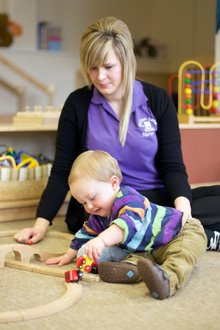World Nursery Rhyme Week is an international celebration promoting the importance of nursery rhymes in early childhood development.
Any family who has been along to a baby and toddler group will be familiar with the part of the session where everyone gathers together to sing songs and rhymes, many of which have actions that go along with them.
Lots of parents and carers sing nursery rhymes to their young children at home, too, particularly if they remember them from their own childhoods.
But fun and enjoyable as they are, there’s actually a lot more to traditional songs and rhymes than meets the eye as they help children to develop a range of skills.
Speech and language development
When children hear rhymes they are hearing a different range of sounds than they would in normal, everyday speech.
The sing-song, rhythmic patterns of traditional rhymes introduce your little one to new ways of using their voice, making it louder and quieter, faster and slower, and with a variety of inflections.
They also get the chance to practise sounds and words without pressure; no one minds if they make mistakes, and there is no danger of being misunderstood, so they can feel free to give words a go.
Nursery rhymes also provide the opportunity for children to hear language being used in unfamiliar ways (including old-fashioned words they might not have heard before). If you're a multilingual family, nursery rhymes can help support a child to learn more than one language.
Early reading skills
Nursery rhymes can also help children to understand the structure of a story.
They usually have a clear beginning, middle and end, which helps your little one to understand what to expect from a story, as understanding sequences of events is a key skill they will need when they begin to read longer stories.
Think of Jack and Jill; they go up the hill, fetch a pail of water, and then it all goes wrong. A whole story in just a few lines, with a lot of rhyme packed in too! This rhyme is very old, so it also introduces your child to words they may not have heard before – pail for bucket, crown for head.
This helps your child understand that there can be more than one word for the same thing, an important concept in English because we have such a rich range of synonyms: different words with the same meaning.
… and writing too!
As your child grows, and starts to write their own stories and rhymes, these early experiences of listening to rhymes will help them to be creative in how they use language, and to realise that when we write, we don’t always have to use words in the same way as when we talk.
Baa Baa Black Sheep, for example, introduces onomatopoeia – a word that sounds like the sound it describes – as well as alliteration, the repeated use of the same first letter to create an interesting effect.
These are all concepts that will be useful later on when your child begins to develop their writing skills.
Learning to count
Many nursery rhymes use basic counting patterns, which can help your child get to grips with numbers and how to count. 1,2, Buckle My Shoe, and Once I Caught A Fish Alive, for example, both use rhyme as a way to help your little one remember the order of numbers 1 to 10, while others introduce the ideas of sequence and size, including counting backwards – think 10 Green Bottles or 5 Currant Buns.
Physical skills
Because so many nursery rhymes involve hand actions or movements, they offer an excellent opportunity for your child to learn how to move their body in a different way, responding to rhythm with their movements and linking particular actions to the different parts of a rhyme.
Building blocks of memory
When children hear the same rhymes repeatedly, whether it’s hearing them every time they’re at an early years setting or attending a family stay and play session, or from parents or carers reciting them at bath or bedtime, they gradually become more and more familiar until they know them off by heart themselves. This helps children to develop the part of the brain that is used for memorization.
Social interaction
Reciting and singing nursery rhymes is a traditional part of circle time at toddler groups or early years settings. Not all pre-schoolers have reached the stage where they enjoy playing with other children, often preferring solitary play or playing alongside others independently, so this is a chance to help a child learn about the fun to be had in joining in and doing something as a group.
Nursery rhymes also offer a great way for parents and carers to interact with their children as it’s a shared activity that often involves lots of positive touch, such as joining hands or counting on each other’s fingers.
These rhymes can also be very comforting to children, as they quickly become familiar, so many parents and carers find that saying rhymes and doing actions together can be a good way of distracting an upset child, or reassuring an anxious one.
Sharing nursery rhymes from your own childhood is a fun way in which to share aspects of your culture and history which will support your child’s sense of belonging and their developing identity.
Whichever rhymes you share with your little one, you can be safe in the knowledge that every time you share a rhyme together, you’re helping them to develop skills and abilities they’ll need when they’re older – and having fun with it too!
Written for the Early Years Learning Alliance by Siobhan Godwood.
This article first appeared on Family Corner in November 2016 under the title 'Rhythm and rhyme to help your child thrive'.
Where next?
Is bilingualism confusing for children?
How to develop your child's emotional literacy







